|
| |
| Hair care |
| |
Day to day Care of your hair
|
 |
Following measures help to keep your hair in good condition and also to reduce hair loss. |
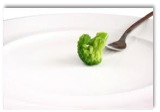 |
Avoid Crash Diets
People on "Crash diets" can experience hair fall for 2-5 months after starting a vigorous weight reduction program. A higher percentage (20-50%) of hair entered the resting telogen phase compared to the normal (10%). Usually they grow back after the diet become normal. |
|
|
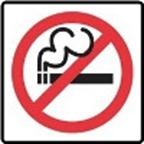 |
Avoid Smoking
Smoking has a profound effect of hair loss. Nicotine and other chemicals affect hair growth of the scalp and increase the level of DHT (dihydrotestosterone) in the hair follicles. A clinical study by the Harvard School of Public Health showed that DHT levels in smokers were 13% higher than in non-smokers. |
|
|
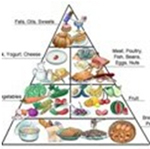 |
Balanced Diet
Malnutrition causes diffuse hair loss. Proteins, carbohydrates, vitamins, and minerals are essential for normal hair growth. After years of researches Dr Inaba (1996) suggested that high intake of animal fat may activate the scalp sebaceous glands to produce more DHT and accelerate androgenetic alopeica. He found an increased tendency toward baldness in the postwar generation of Japanese men who have adopted a Western-style diet overly rich in animal fats. A diet low in saturated animal fat is strongly recommended. Supplement : Orally may be required in some. Beware of high dose of vitamin A which can itself cause hair loss. Iron is recommended for females with menstrual flows or vegetarians. The supplement should contain 2 other important minerals: zinc and copper. |
|
|
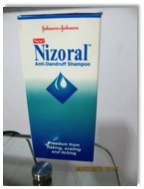 |
Choice of Shampoo
It does not really matter, as most have no effect on hair growth or structure. All you need is a mild detergent that removed dirt and grease.
Expensive shampoo serves no additional purpose as all the ingredients (and your money) wash down the drain rather than staying on your scalp. More important is proper rinsing afterward to avoid accumulation of chemical residuals on the skin. For the same reason you should change your shampoo from time to time.
The only shampoo reported to have effect on Androgenetic Alopecia was Ketoconazole 2% shampoo. |
|
|
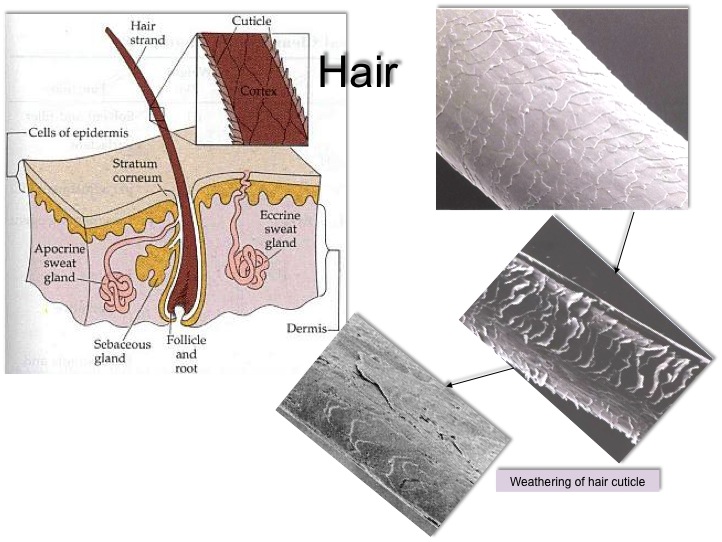 |
 |
| Use of Hair Conditioners and Hair oil: |
 |
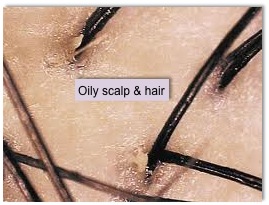 Cuticle, the outer layer of Hair shaft, is composed of overlapping dead keratin in the appearance of scales. When hair is in good conditions, the keratin adhered tightly to the shafts making it shiny and smooth. Once hair weathers or damaged by improper hair treatment, it begins to look dull and cracked on the edges. Cuticle, the outer layer of Hair shaft, is composed of overlapping dead keratin in the appearance of scales. When hair is in good conditions, the keratin adhered tightly to the shafts making it shiny and smooth. Once hair weathers or damaged by improper hair treatment, it begins to look dull and cracked on the edges.
Hair conditioners work mainly by forming a "coating" on the cuticle to increase the strength and return the shiny appearance. However some conditioners contain strong detergents which when permeating downward through the skin, may harm the dermal papilla. Also excessive use of hair conditioners increases sebum on the scalp surface and blocks the sebaceous duct opening.
Consequently conditioners should be applied to the hair shaft only, not the scalp. They should be properly rinsed off after application. The use of combined shampoo-conditioner formulation is not sensible. Hair oil is a natural conditioner but make the skin and hair oily.
|
 |
| Frequency of Hair Wash |
 |
There is no absolute standard because it depends on the condition of the hair and the scalp, whether the hair is soft or hard, and whether the dandruff is oily or dry.
Those on Minoxidil may choose to shampoo at least once a day to avoid irritation from the residual. Those with Dry scalp and hair should use the shampoo less often then those with oily scalp who may use daily. |
 |
| Hair Brushing |
 |
Brushing can cause the sebum at skin pores to slide upwards along the hair. It serves 2 purposes |
 |
- Decrease oil on scalp surface can prevent clogging of the sebaceous opening and enlargement of the sebaceous gland.
- Lubricates the hair shaft for a more shiny look.
Nylon brushes are known to generate static electricity, which causes hair to twist and coil, and can lead to hair loss. Brushes made of stiff pig or boar bristles are recommended. |
|
Nylon brushes are known to generate static electricity, which causes hair to twist and coil, and can lead to hair loss. Brushes made of stiff pig or boar bristles are recommended. |
 |
| Hair Styling |
 |
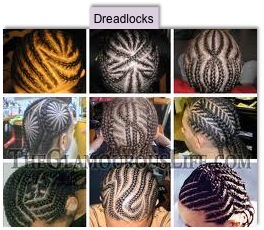 Constant tight pulling of the hair by braiding or "pig-tail" causes hair loss. Damage to the follicles may be permanent. This Traction Alopecia is especially common in African female. Beware when your hairline starts to recede. Avoid using tight comb or brush on the wet hair witch can be more damaging to your hair. Let the hair dry and use wide comb to start combing from the distal end of hair towards the scalp end of the hair doing small segments rather than starting directly from the scalp end towards the distal end witch may give too much traction on the root and can be damaging. Rishi Knot in Sardarrs and Constant tight pulling of the hair by braiding or "pig-tail" causes hair loss. Damage to the follicles may be permanent. This Traction Alopecia is especially common in African female. Beware when your hairline starts to recede. Avoid using tight comb or brush on the wet hair witch can be more damaging to your hair. Let the hair dry and use wide comb to start combing from the distal end of hair towards the scalp end of the hair doing small segments rather than starting directly from the scalp end towards the distal end witch may give too much traction on the root and can be damaging. Rishi Knot in Sardarrs and
Stress
Stress is NOT a cause of Androgenetic Alopecia, but it can precipitate another form of hair loss, the Telogen Effluvium. So be relaxed.
|
 |
| Dandruff |
 |
 |
For Dandruff (seborrheic dematitis) know 3 important facts:
1. Dandruff is not a disease it is a cleanliness problem
2. Dandruff is not the cause of hair loss as it is commonly believed.
3. When one has excess hair fall or has more cyclical turnover of hairs due to short hair cycle of hairs in pattern hair loss the skin cell turnover also increases and that is the cause of more dandruff and not the other way round.
Dandruff is the dry dead top layers of skin as the new ones grow under it. The dead layers form dry scales, which remain stuck to the skin. In the people with oily scalp this dry scale becomes sticky or oily and even dark in colour. They need to be separated by rubbing with the tip of the fingers from the skin of the dry scalp before using a shampoo. Those having excess hair fall due to genetic, hormonal or some other reasons avoid washing the scalp thoroughly due to the fear of more hair fall. Due to Pattern Hair loss developing your hair cycle becomes shorter and therefore your skin cell turn over increases. Well hair fall is not related to dandruff as commonly believed. The hairs which would otherwise fall in next few days will fall during hair wash, oiling, massage of scalp etc. This increased hair fall during washing make them avoid hair wash frequently. So every time they wash their say every 5th day there will be a fall of 5 days quota of hair fall. This will fear them more. Well wash the hair and more importantly scalp skin regularly and if necessary daily to avoid dandruff accumulation. In few days you would notice that dandruff is well under control and hair fall during hair wash is also minimized. This will save you from spending fortune after various antidandruff shampoos either.
Dandruff is one of the most common cosmetic problems of non-inflammatory nature leading to increased scaling of scalp affecting one in every five individuals. It is known under various dermatological terms such as Pityriasis Siccal P. Sleatoides/ P. furfurance. It may or may not be accompanied by itching. It is usually characterized by white flaking of the scalp with the scales falling on the shoulders, neck and back.
Well our hair root is richly supplied with blood vessels but once the hair is formed and reaches the surface no nutrition reaches there in other words the hair once formed is not having life and it can not repair it self after injuries by any external agent of chemical, physical or thermal nature. |
 |
| Hair Nutrition: |
 |
|
|
Although one must know that hair needs Protein ( Keratin) which is formed from Amino acids ( esp. L -Lysine), certain Vitamines ( Vit. A, Vit B6 B12, Biotin, Vit D and Vit E) and Minerals ( esp. Iron and Zink).
Dieting, Starving, Bariatric surgery ( for weight reduction) etc. can cause deficiency of one of these nutrients for the hair and can cause hair loss or growth problem. Although this is not common and esp. not in those who take regular balanced diet.
Deficiency should be diagnosed and can be treated by appropriate nutritional supplements. In females Iron deficiency is not uncommon due to monthly blood loss.
It takes 3-6 months before any change can be perceptible on regular treatment for deficiency correction. The miracle cures should be looked at with suspicion. There is no overnight cure.
The kind of picture that you have should be investigated for miniaturization studies and other tests to rule out Pattern Loss or other causes instead of simply taking vitamins. In fact excess of Vit A can cause other problems besides increasing your hair loss. |
 |
| Hair Dyes: |
 |
|
|
No longer are dyes used only to camouflage graying hair, but colouring agents & dyes are actually used to highlight and accentuate hair colour. Hair dyes can be classified into 2 major types: - Semi-permanent and permanent hair colouring agents |
- Semi-permanent hair coloring
- The originally developed hair dyes are the vegetable dyes. These generally fall under the semi-permanent category as they only minimally penetrate the hair cuticle.
The most popular vegetable dye used is henna. This is derived from the Lamsonia Alba plant. The dried plant leaves are ground to form a powder that is activated with water to form an acidic naphthoquinone dye. This is applied as a paste to the hair for 40-60 minutes. The henna imparts a reddish hue to the hair. Nowadays, synthetic henna formulations are available which are superior to the natural henna formulations, as they do not leave the hair as stiff and brittle as the natural ones even after repeated applications. In spite of its semi-permanent nature, henna also requires 4-6 washes before it comes out fully. The biggest advantage of henna is that it is not really known to cause allergic contact dermatitis
- Permanent Hair Colouring
- The hair dye penetrates the hair shaft to the cortex and forms large colour molecules that cannot be removed by shampooing. Re dying is necessary every 6 weeks or so. Permanent hair colour damages the hair shaft by increasing its porosity, making it more brittle, harder to untangle and also increases static electricity. Hence, they should not be used more frequently than 5-week intervals. The most important, being PPD - Paraphenylene diamine. It is most commonly known to cause allergic contact dermatitis and hence patch testing is a must before using this product.
Permanent color is produced by the oxidation of the primary intermediate by hydrogen peroxide to produce an amine. The hair must be saturated with the product and then the excess dye is rinsed.
- Gradual hair dyes
- Metallic Dyes left in situ - gradually darken hair. More details on Blog…
|
Hair styling by Pinning, Bands, clips, rubbers bands for hair |
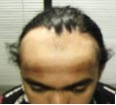 Apart from contact dermatitis in susceptible individuals to any of the products used - the most important side effect is TRACTION ALOPECIA. Overzealous pulling back and pinning of hair leads to receding of the hairline and loss of hair due to destruction of hair follicles. Turban Alopecia seen in Sikhs is a traction alopecia and more details are on Blog Apart from contact dermatitis in susceptible individuals to any of the products used - the most important side effect is TRACTION ALOPECIA. Overzealous pulling back and pinning of hair leads to receding of the hairline and loss of hair due to destruction of hair follicles. Turban Alopecia seen in Sikhs is a traction alopecia and more details are on Blog
|
 |
| Perming of hair: |
 |
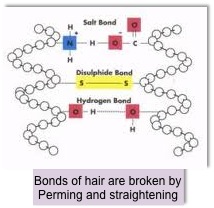 Hair is usually relaxed into a tighter curl than actually required. Waving involves reshaping of hair and "locking" it into the reshaped state. Normally when the hair is set into a "curl", it has a tendency to straighten itself again, because of the stretching of the disulfide bond & Gravitational forces. The perming lotion breaks the disulfide bonds between the keratin molecules in the cortical cells and reforms them in a new position. A permanent wave lasts 3-4 months. Hair is usually relaxed into a tighter curl than actually required. Waving involves reshaping of hair and "locking" it into the reshaped state. Normally when the hair is set into a "curl", it has a tendency to straighten itself again, because of the stretching of the disulfide bond & Gravitational forces. The perming lotion breaks the disulfide bonds between the keratin molecules in the cortical cells and reforms them in a new position. A permanent wave lasts 3-4 months.
Hair shafts become weaker by 17% therefore they are less able to stand trauma of combing and brushing. They fracture or brake from shaft. Hair becomes more difficult to comb because of increased frictional resistance.
Irritant and allergic contact dermatitis can occur
|
 |
| Hair straightening |
 |
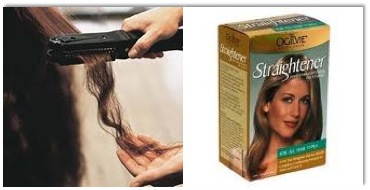 This is used for patients with curly hair. It is of 2 types temporary and permanent. This is used for patients with curly hair. It is of 2 types temporary and permanent.
Temporary (heat): A metal comb heated to 300 to 500 F is passed repeatedly through the hair. Along with this a pressing cream containing oily substances such as petrolatum is used to help transfer heat and also in faster movement of comb through hair. This method breaks fewer bonds than chemical straightening.
Permanent (Chemical): Chemicals such as ammonium bisulfide, thioglycollate or sodium hydroxide are used. The principle is same as hair waving or perming. The side effects are similar to perming and should not be done more than 3 times a year.
|
 |
| Hair cosmetics & Hair care products |
 |
- Hair oils : Usually consist of natural ingredients like vegetable oils e.g.: castor, olive, peanut, sesame, almond, rosemary, wheat germ and the most popular coconut oil. These also include herb oils like henna, Amla and Brahmi oils. Largely aid in hair grooming. Doubtful value as far as hair growth is concerned - however traditional use continues. Shampoo your hair immediately. Since hair oils attract dirt and dust wash your hair with a good shampoo after heavy oiling. It is ideal to oil hair before every wash but daily application has adverse effects as it results in the sticky condition of the scalp causing accumulation of dandruff.
- Hair tonic or nurisher: non-greasy preparations with doubtful scientific value.
- Hair shampoos: "Shampoo" is an Indian word meaning massage. It is primarily a hair care product, which contains a mixture of detergents, oil (fat) and water in varying proportions that is useful for cleaning hair and scalp. Detergent causes degreasing and removes sebum. Some sebum has to be left behind or put back to achieve soft, shining hair. They may also contain softeners, conditioners, colouring agents, preservatives, opacifiers, sequestering agents etc.
Before selecting a shampoo it is important to identify ones hair type.
Hair that does not have sheen to it, gets knotted easily and splits at the ends is dry hair. Very limp hair and sticky to the scalp is oily hair. Hair, which is flowing, easy to style and maintain, easy to brush and comb and has a nice shine to it with no split ends are normal hair. They are easily adaptable to new styles.
Brush hair thoroughly to remove surface dirt, loosen scalp debris and help eliminate tangles.
Wet hair thoroughly, works the shampoo into lather as you apply it on the scalp. Massage the entire scalp gently in circular motion with your fingertips for a few minutes. Rinse the hair thoroughly with warm water. Finally rinse with cold water to stimulate circulation. Dry gently with a soft towel.
How often should hair be shampooed?
Normal hair - Shampoo weekly
Oily Hair - As often as required
Dry Damaged hair - Shampoo weekly
Dandruff problem - Twice a week till dandruff is under control.
How do I select a shampoo for my hair?
If shampooing too often causes more hair problems than it solves first switch to a milder shampoo. If that does not work shampoo less frequently. Only with trial and error technique will you hit on the formula that works for your hair.
What shampoos cannot do?
No shampoo can "nourish" the hair Shampoos cannot make hair grow faster, grow longer or thicker. They cannot reverse graying of the hair. Shampoos do not cause hair loss
Avoid shampoos that make the hair extra dry or cause scalp flaking, and those which make hair squeaky and difficult to finger comb while rinsing
Types of Shampoos
Basic shampoos
Oily hair shampoos: excellent cleansing/minimal conditioning.
Normal hair shampoos: good cleansing/moderate conditioning.
Only useful for coarse, reasonably seborrhoeic hair.
Dry hair shampoos: mild cleansing/good conditioning reduces static electricity, increase manageability,
Damaged hair shampoos: These are for hair chemically treated with permanent hair colours, bleaching agents etc. They are even milder than dry hair shampoos.
Baby shampoos are indicated for babies who produce limited sebum. They are usually amphoteric.
Medicated (anti-dandruff shampoos)
Normal shampoos with additives like tar, salicylic acid, sulfur, selenium sulfide, ZPTO or azole derivatives. What they do is cleansing efficiently, removal of scalp scales, decreases scalp scale production (antimitotic), antifungal and antibacterial action. Market preparations are Nizral, Ketodan, Selsun, Ionax-T, Scarpe, Head and Shoulders, All clear.
These are cosmetic products designed to aid in styling the hair and maintaining the style in place. They also provide conditioning, style, shine and manageability. Depending on the ingredients, they can be applied on dry or wet hair.
- Hair conditioner: Defined as a product generally applied to the hair to improve its cosmetic appearance and feel. There are plenty of traditional conditioners, like extract of hibiscus, neem etc. Modern day conditioners contain oils, waxes and silicones to lubricate and smoothen the hair. Other additives are Surfactants, cationic agents, hydrolyzed animal or silk protein, vitamin E, Pantothenol, sun screens etc. They provide lubrication and gloss. They restore protective acidic film of hair. They have anti-static properties and hence prevent tangling and breakage. Cuticle adhesion to hair shaft is induced, thereby reducing inter shaft friction. This adds to the softness and gloss of hair. They temporarily seal split ends.
Type of conditioners
Instant conditioners: These are left in contact with hair for 5 minutes immediately after shampooing. They are quick to act but their action is for a limited time.
Cream conditioners: Concentration of ingredients is more. They remain on the hair for longer periods (20 minutes). They work better in conjunction with heat (dryer/warm towel); heat causes hair shaft swelling and hence better penetration of conditioner. They are most useful for extremely dry hair.
Leave on conditioners: They are not rinsed off and remain till the next shampooing.
Blow-drying lotions: Mainly for patients with fine hair and excessive sebum production.
Hair glaze: also known as hair thickeners. They provide a coating on each shaft that increases its diameter minutely.
Sun protective conditioners: Excess sunlight causes damage to melanin and keratin structure of hair. Hair protein degradation is caused dry UV rays 250-400 nm. It makes them stiff, dry, lusterless and brittle. Products are Ultradoux, Flex, Samara, Biotique.
- Hair creams / oily dressings: They provide conditioning, style, shine and manageability.
A film of oil is used to control the dry hair before combing it into a style. Cream is an emulsified oily dressing e.g. Brylcream or Brillantine. These contain mineral oil / isopropyl myristate.
- Hair Sprays: Aid in styling the hair and maintaining the style in place. These contain polymers they form a thin film on hair that holds it in place and can be easily removed by shampooing. They are of 2 types Regular hold & Super hold - Contains increased copolymer. Adverse reaction: - Induces temporary hair coarseness and rough feel applied to their shafts by combing on to wet hair. It imparts a wet look and stiff feel to the hair. They are available as Styling gels & Sculpturing gels. They are useful in people with dull thinning hair to create an illusion of fullness by holding the hair away from the scalp.
- Hair styling Gel & mousses: This is a PVP and VA containing and pressure foam released spray from an aerosol used can. They are applied on damp or dry hair and give a much weaker hold than gel formulations. They also may contain colouring agents to create / blend gray hair.
|
 |
| Hair removal |
 |
- Shaving
Most widely practiced method, as it is most economical and rapidly effective. air is cut at the skin surface level in shaving. SHAVING DOES NOT INDUCE AN INCREASED RATE OF HAIR GROWTH.
- Threading
Practiced mainly for eyebrow and facial hair. Performed by looping a common thread around the hair, twisting it across the skin so as to cut the hair at the level of skin surface. Adverse reaction: folliculitis.
- Plucking
Another physical method where hair is grasped by tweezers and then plucked off removing entire shaft and hair bulb. Hence, hair growth takes longer to become apparent.
- Waxing
A variant of plucking where hair is plucked en masse and removed at the level of hair root. Hair regrowth, therefore takes time. It is popular in women who get various areas such as legs, arms, underarms waxed to remove body hair all over. There are 3 methods
Hot or warm waxing: generally used by beauty parlors.
In hot wax - paraffin wax along with beeswax, resin, petrolatum and mineral or vegetable oil are melted with direct heat (50oC) and then applied along the direction of the hair with a spatula in long, narrow bands. Wax is allowed to cool and set to form hardened strip embedding the hair. The solid wax is then lifted and stripped away in one piece bringing the embedded hair with it.
Warm waxing: Similar to hot wax (but temp 430C) hence adheres efficiently to very short hair.
Cold waxing: can be done at home - more hygienic
- Bleaching
It is used most often for unwanted facial hair. Pigments are changed to a lighter or colourless form by the process of oxidation. H2O2 is the main oxidant used - first made alkaline by mixing it with either an oil bleaching or powder bleaching. Extreme alkalinity and strong H2O2 can be damaging to both skin and hair.
- Electroepilation
Method of permanent removal of hair by destroying its bulk with various electrical techniques.
The needle is inserted into the follicular opening to the level of follicular germinative cells. These along with dermal papillae are destroyed facilitating permanent hair removal. Depending on the type of electrical current used electroepilation is classified into 3 types:
- Electrolysis: (chemolysis) using direct (galvanic) current
Thermolysis: using high frequency alternating current.
Blend: using combination of both direct and A.C. current
IT MUST BE ENSURED THAT THESE PROCEDURES are always performed by skilled and trained operators
- Laser epilation
This is the latest technique where rays from specialized laser machine are absorbed by melanin pigment causing photothermolysis. This is requires multiple sittings and there could be some problems of pigmentation esp. in dark skin. Thick hair is resistant.
|
 |
|